
Millstone Types: British Sandstones and Conglomerates
Old Red Sandstone, Puddingstone, and Lodsworth Stone
AKA Welsh Stones, Greensand
Singleton Mills homepage > Overview of Stone types used for Millstones > Old Red Sandstone, Puddingstone, and Lodsworth Stone
Milling with British sandstone and conglomerate
In Britain, sandstone and conglomerate rocks were used for flour milling for centuries. In earlier times, small primitive hand-powered mills called 'Querns' were cut from these stones. Then later, much larger, full-sized Millstones were quarried for use in watermills and windmills.
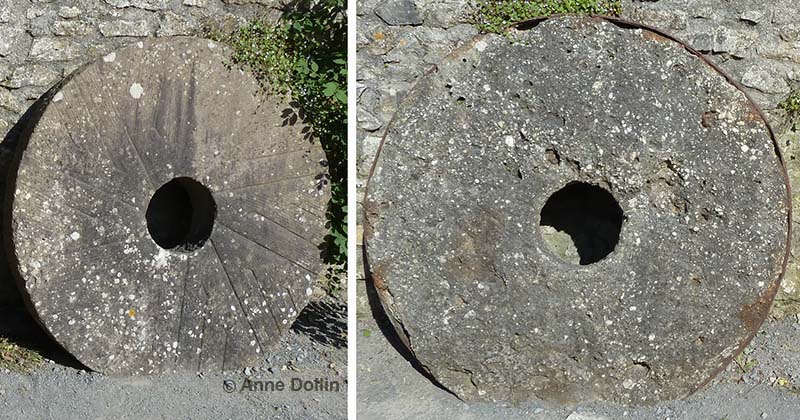
Above, two old millstones on display at Carew Castle in Wales, UK: left, a millstone made from a fine sandstone rock; right, a millstone made from a coarse conglomerate rock. These millstones are both over 1m in diameter. Photographs by Anne Dollin.
The best sandstones and conglomeratesA for making millstones are generally rich in silica. Because silica is such a hard mineral, silica-rich rocks tend to be very durable.
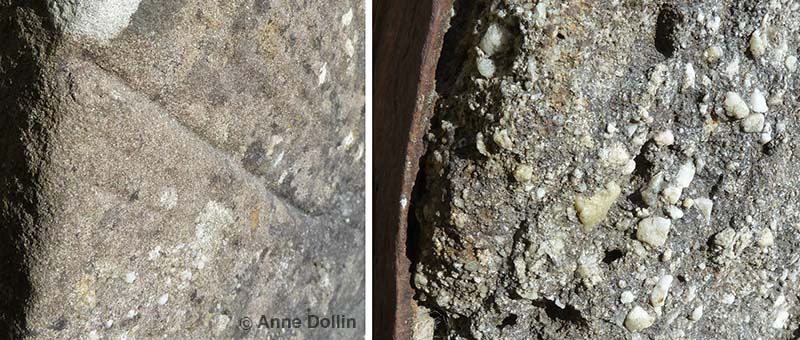
Above, detail of the stone texture in the two Carew Castle millstones shown previously: left, the sandstone millstone contains very fine sand grains of uniform size; right, the conglomerate millstone is made from rock containing quartz pebbles, up to about 30mm in diameter, embedded in a matrix with finer sandy grains. Photographs by Anne Dollin.
In the United Kingdom (UK), Millstone Grit was the most widely used sandstone for making millstones. However, three other sandstones and conglomerates used for milling in the UK were Old Red Sandstone, Puddingstone and Lodsworth Stone – described below.
A: Sandstones vs conglomerates. Sandstones are composed of quartz sand grains cemented together into a rock. Conglomerates are small pebbles and finer sediments, such as sand, cemented together.
Devonian Old Red Sandstone (ORS)
This sandstone material was deposited about 400 million years ago in the UK, and in parts of Europe and North America. Key deposits are found in the Bristol and Mendips areas of England.
It is a variable stone type. It is typically red, due to traces of iron oxide, but can also be grey, green, or purple. Some types are fine-grained, some are coarse-grained, while other types contain small pebbles of quartz or chert. It largely has a quartz or silica cement.
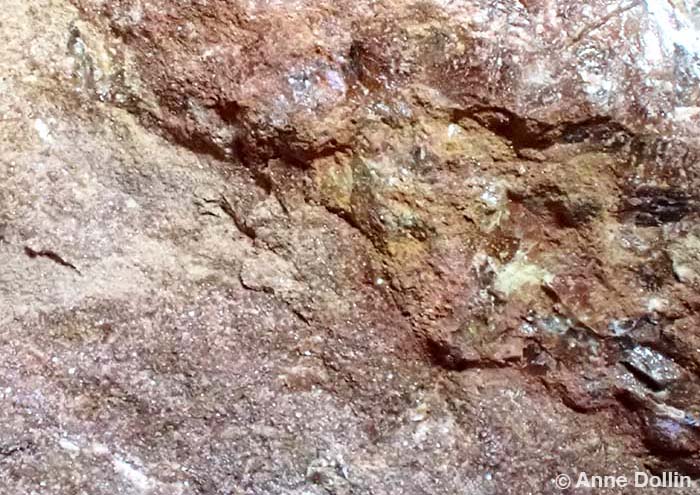
Above, detail of some Old Red Sandstone from Somerset, UK, with a variety of grain sizes and colours. The full width of this image shows a 20mm-wide section of the stone. Macro image by Anne Dollin.
Puddingstone
This eye-catching conglomerate rock is made of quite large, rounded pebbles bound together in a pale, silica-rich cement. It is well named for its resemblance to our traditional plum puddings! Notable deposits of Puddingstone are in Hertfordshire in England, and near Penallt in southern Wales.
Puddingstone consists of flint pebbles or cobbles bound in a tough, cavity-free cement of sand and silica that does not abrade easily. In fact, the cement is said to be so hard that the rock will break through the pebbles and the cement alike if struck with a hammer.
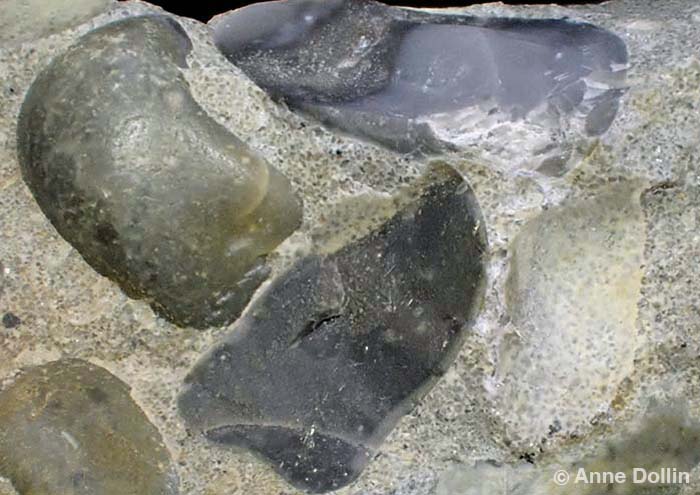
Above, detail of some Puddingstone from Hertfordshire, UK, with large, rounded flint pebbles embedded in a pale cement containing fine stone particles. The full width of this image shows a 20mm-wide section of the stone. Macro image by Anne Dollin.
Lodsworth Stone
Lodsworth Stone is another British sedimentary sandstone that was used for milling flour in early times. It is a hard green-grey or brown-grey stone, high in silica. Also called Lower Greensand, it is found in southern England.
How these three stone types were used
British Lodsworth Stone was mostly used to make small, primitive hand mills called 'Querns' from Neolithic through to Roman times.
However, Old Red Sandstone and Puddingstone were used in the UK to produce both querns (see below) and the much larger millstones (shown in the first image on this webpage).
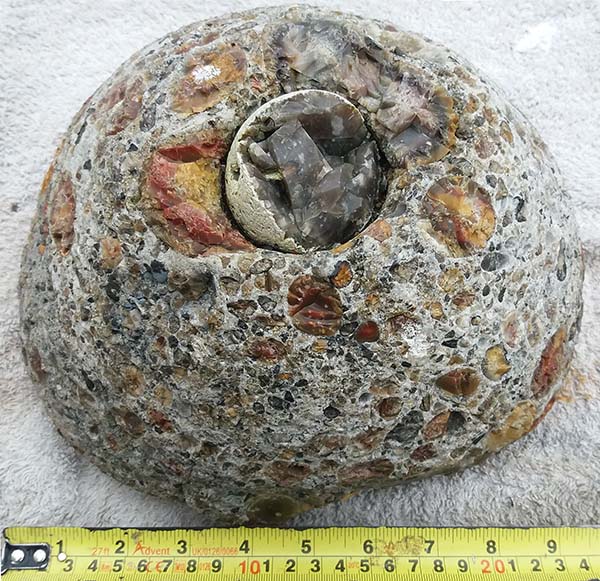
Above, the top stone of a puddingstone Beehive Quern, found in Suffolk and dating from the late Iron Age or Roman period, about 1–160 AD. The distinctive, brightly coloured pebbles in this puddingstone material are clearly seen. The large flint nodule, jammed in the central hole of this quern, is not part of this mill. A flat lower stone would originally have been fitted underneath this upper stone. Grain would have been fed in through the central hole, and ground by hand between the two stones. This quern was about 23 cm in diameter and 18 cm high. Photograph by Suffolk County Council, Alexander Bliss. Wikimedia Commons.
SOURCES INCLUDE:
1. Shaffrey, Ruth (2021) Supplementary material in Feeding Roman Silchester: Querns and Millstones in and around Roman Towns. Britannica, Vol 52, Cambridge University Press.
2. Ingle, Caroline Jane (1989) Characterisation and distribution of beehive querns in eastern England. PhD Thesis. University of Southampton.
3. Tucker, Gordon (1980) Millstone making in Anglesey. Wind and Water Mills, 1: 16-23.
4. Green, Chris, Hertfordshire Puddingstone. Hertfordshire Geological Society website.
5. Shaffrey, R and Roe, F (2011) The widening use of Lodsworth Stone: Neolithic to Romano-British quern distribution. In: Bread for the People: The Archaeology of Mills and Milling. D Williams and D Peacock (eds). University of Southampton.
Read More About Millstones
•• Overview •• French Burr Stones •• Basalt-like Cullin Stones •• Millstone Grit •• Granite •• Limestone •• Artificial Millstones •• Norfolk Island Millstones •• Colonial Millstones ••